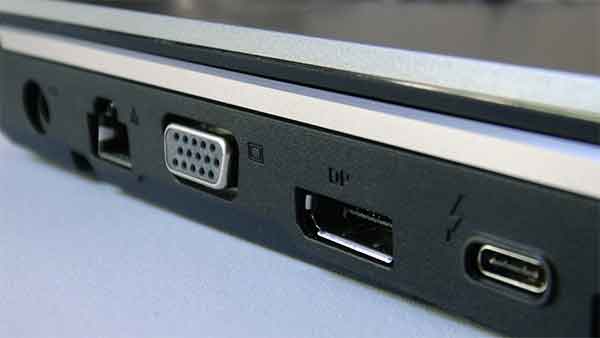
The CELSIUS H760 is more than a desktop replacement mobile workstation. It is the ultimate hotrod-workstation for engineers on the go.
At CADplace, we have never had such a well-equipped mobile workstation in our labs. This road warrior came to us ith NVIDIA Quadro M2000M graphics, an Intel Xeon CPU, 64 GB memory capacity, a 4K resolution display, and PCIe NVM Express SSD storage. It sports every connector imaginable including the latest C-type USB interface. You can believe us that the performance doesn't disappoint. But first, let's get an overview of this machine.
 This 15 inch (15.6”) mobile workstation delivers the kind of performance you might expect to find only in a larger 17” system. The system weighs in at 2.75 kg with a 380x257x35 mm form-factor. This size and weight is remarkable given the expandability of the system.
This 15 inch (15.6”) mobile workstation delivers the kind of performance you might expect to find only in a larger 17” system. The system weighs in at 2.75 kg with a 380x257x35 mm form-factor. This size and weight is remarkable given the expandability of the system.
The chassis is a classic CELSIUS H Series design: steel gray with red accents. The styling and the design is easy on the eyes. The keyboard has a low-profile design with a soft, responsive touch. It is an engineering machine, so it naturally has a full-sized keyboard including a number pad. Navigation is assured through a 3-button touchpad and a touch-stick. The PalmSecure identification sensor is situated on the right side of the palm rest. The CELSIUS H760 can be equipped with an optional fingerprint sensor.
The CELSIUS H760 keyboard provides a responsive touch, stylish design, and a separate number pad. There is also an option for a backlit keyboard.
The display is a 15.6” display with a 4K (3840x2160) resolution and an anti-glare finish. At CADplace, we have seen vendors choose a glossy finish for the display. The stated benefit of a glossy display is to deliver a more accurate color. I find the anti-glare finish on the CELSIUS H760 delivers fine color definition and is much, much easier to view than a glossy display under the multitude of lighting situations that occur while traveling. It is clear to us at CADplace that the anti-glare finish is the right choice for a mobile workstation that targets mobile designers and engineers.
The front edge of the system has six LED indicators which are essentially useless in this day and age. The right side sports a Kensington lock connection, a USB 2.0 port and an optical drive bay. The optical bay can be configured with a Blue-ray disc writer, a DVD, an extra hard drive, or an additional battery. The left side of this mobile workstation is loaded with connectivity options. Here you will find nearly every connector imaginable. The CELSIUS H760 has an ethernet connection, a VGA output, a DisplayPort output, a Type-C USB connector, 2 USB 3.0 connectors, a SD-card reader, a SmartCard slot as well as microphone and headset jacks. The Type-C USB connector provides USB-3.1-, DP-1.2-, Thunderbolt3- and Power-Delivery-functionality up to 15W.
On the bottom of the unit is the interface for the docking station. The docking station provides two DisplayPort outputs, a DVI-I output , a VGA output, an Ethernet connector, four USB 3.0 connections, a microphone jack and headset jack.
The extra attention to connectivity means that you will probably never be missing the right type of output when traveling with the CELSIUS H760.

On the inside, this road warrior is equipped with the latest technology. Graphics may be the most important technology in a mobile workstation. This system came equipped with an NVIDIA Quadro M2000M GPU. This GPU launched at the end of 2015 and is based on the Maxwell architecture. It is built using a 28 nm process and has 1.87 billion transistors. It has 640 CUDA cores, uses 4 GB of GDDR5 memory with a memory bandwidth of 80.2 GB per second. It is a GPU that handles most graphics tasks with ease.
Customers have a choice of graphics options. They can choose the Quadro M2000M as came in our review system, a Quadro M1000M, or a Quadro M600M graphics processor.
Fujitsu provides nearly every type of connectivity which a professional workstation user could require including multiple options for display output.
Fujitsu allows for a range of CPU configurations in this workstation. Our system came with an Intel Xeon E3-1535M v5 CPU running at 2.9 GHz (up to 3.8 GHz). The Intel Xeon E3-1505 v5 CPU running at 2.8 GHz is also an option as are two Core i7 CPUs and an i5 CPU model. The high-performance, quad-core Intel Xeon processors are excellent CPU options for clients with demanding applications in simulation and rendering. A fast CPU is also helpful in complex 3D CAD in order to keep the graphics pipeline full for the Quadro M2000M.
This system came with the maximum memory configuration of 64 GB. Your memory requirements depend on your workloads and your workflows. During the CADplace tests, we easily ran up the memory usage to 20-25 GB while working on video. CAD modeling applications used anywhere from 6-12 GB of memory. Data-intensive workflows such as those using 3D CAD, simulation, and post-processing visualization are examples where customers should consider the maximum memory configuration.
High-performance storage is critical. It makes loading applications faster. It makes saving large projects faster. And it adds balance to a system which uses powerful graphics and processors. The CELSIUS H760 which CADplace tested came with SSD storage. But not just any SSD storage. Our system came with M.2 PCIe SSD storage which is not only blazing fast SSD storage but attached to the PCIe bus interface. This provides the mobile workstation with faster overall throughput in the storage system and helps to eliminate bottlenecks in the workstation performance.
One of the best professional benchmarks to evaluate the performance of a graphics workstation is SPEC.ORG's Viewperf 12 benchmark. The benchmark is created by an industry consortium. It uses typical data-sets from applications like CATIA, CREO, SolidWorks, and others. The results are a weighted average of performance measured in frames per second (FPS).
Here are the Viewperf performance numbers for the CELSIUS H760.
Test |
Result |
|---|---|
| CATIA-04 | 45.79 |
| CREO-01 | 38.79 |
| ENERGY-01 | 3.05 |
| MAYA-04 | 36.82 |
| MEDICAL-01 | 14.25 |
| SHOWCASE-01 | 23.04 |
| SNX-02 | 32.78 |
| SW-03 | 67.02 |
To put these results in perspective, these numbers are almost all more than 50% of the performance of the desktop version of the Quadro M4000 running with a 3.0 GHz Intel Xeon CPU. Even more impressive is that these Quadro M2000M results are achieved with 640 CUDA cores compared to the 1664 CUDA cores on the Quadro M4000. In addition, these results are significantly faster than a desktop workstation running with the Quadro K1200 with its 512 CUDA cores.
CADplace tested the interactive 3D modeling performance with 3DS MAX and our Ferrari models. This system delivered an excellent frames per second (FPS) result of 130 to 160 FPS with a single Ferrari model. With the much larger 50 Ferrari model, the CELSIUS H760 still performed with a nicely interactive 11-12 FPS.
d

Adobe Premier Pro CC is a great application to test the benefit of the NVIDIA Quadro GPU. Adobe's Mercury Playback Engine (MPE) can use either CUDA with GPU acceleration for playback and video rendering, or it can use a software-only mode. The CADplace test case uses multiple video streams with color correction and transparency to measure performance as well as GPU and CPU workloads while rendering video with different levels of complexity.
I can summarize the interactive video-editing performance quite simply. Using CUDA, it was possible to playback the video in realtime with one, two, three, and four simultaneous video streams smoothly without stuttering or dropping frames. With software-only, this was not at all possible.
In addition, rendering final quality video is significantly faster using the Quadro GPU. As you can see in the test results below, the rendering times were always much faster using CUDA than when using the software-only rendering. In fact, for one and two simultaneous video streams, the MPE using CUDA and the Quadro M2000M GPU could render the final video faster than realtime playback.
By combining the Quadro M2000M GPU, Xeon CPU, and fast PCIe SSD storage, the CELSIUS H760 delivers interactive 3D performance with models of over 10 million vertices.
The results below show the number of seconds required to render a second of video. Numbers below one are rendering times faster than realtime playback. Rendering results greater than one are slower than realtime playback.
Premier Pro CC Video Rendering Performance:
Premier Pro CC |
CUDA |
Software |
|---|---|---|
| One video stream | 0.53 sec/sec of video | 1.53 sec/sec of video |
| Two video streams | 0.67 sec/sec of video | 5.53 sec/sec of video |
| Three video streams | 3.28 sec/sec of video | 11.18 sec/sec of video |
| Four video streams | 3.83 sec/sec of video | 13.58 sec/sec of video |
The NVIDIA Quadro M2000M is clearly faster. It can range from three times faster to six times faster than software-only video rendering. This performance advantage can be found in areas besides video editing. NVIDIA Quadro GPUs accelerate realtime ray-tracing rendering with NVIDIA iRay. NVIDIA iRay plugins and technology can be found in many popular applications including 3DS MAX. NVIDIA Quadro GPUs can also accelerate different problems in CAE simulation.
The PW perspective:
Fujitsu has a long history in professional workstations. They shipped the world's first mobile workstation in 1999. This latest generation of CELSIUS H Series mobile workstations takes every important technology to a new level. Doing this in a sleek design and a 15 inch format is a testament to the company's engineering and design skills. The result, the CELSIUS H760 mobile workstation is a mobile road warrior that will get the job done for you fast – in the airport, on the train, at home, or in the office.





